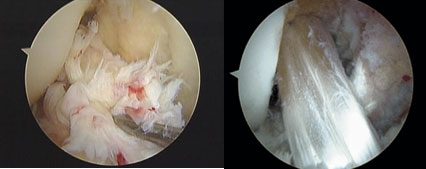ACL Reconstruction
Regardless of graft choice the surgery is essentially the same. Four small incisions are made around the knee and work is done to remove the old, torn, ACL and anchor in the new graft. During the surgery, tunnels are created in the tibia and femur and the graft is passed through these tunnels and anchored on both sides to allow it to heal. The surgery takes roughly one to two hours and patients are allowed to go home the same day.
Recovery following ACL reconstruction takes roughly 6-8 months. While patients are allowed to bear weight right after the procedure, activity is restricted initially to allow the graft to heal and incorporate into the bone. Patients will wear a hinged knee brace locked at 0-30 degrees for the first three to four days then will start working on full range of motion. We instruct patients on starting their own therapy within days of surgery and are encouraged to get on a stationary bike with no resistance after two weeks and work on getting off crutches and regaining motion. The goal is to obtain full range of motion within the first four weeks.
About four weeks after surgery, formal supervised physical therapy is started to regain motion and strength and patients usually require therapy for about three to four months. Patients are asked to stay away from impact activities, such as running and jumping, the first four months, and lateral, side-to-side, pivoting and cutting motions are restricted until about six months after surgery. Most patients are able to return to all of their pre-injury activities such as golfing, weightlifting, baseball, football, skiing, tennis, dancing, and basketball.

